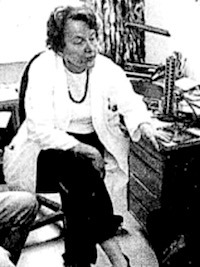Ingegerd Larsen
Ingegerd Frøyshov Larsen (1937 – present) is a Norwegian physician and endocrinologist.
Larsen is eponynomously known for her research into Hansen-Larsen-Berg syndrome – a syndrome of total colour blindness, secondary to progressive cone dystrophy; degenerative liver disease; and endocrine dysfunction – which was first published in 1976.
Biography
- 1937 – Born Ingegerd Frøyshov on August 2 in Oslo, Norway
- 1962 – Graduated medicine from the University of Oslo
- 1964 – Trained in paediatrics at Northwestern Hospital, Minneapolis
- 1965-1969 – Head of the mother and child clinic run by the Norwegian Refugee Council in Amman, Jordan
- 1969 – Married Øyvind Larsen, professor of medical history at the University of Oslo
- 1970 – Assistant physician in the department of endocrinology, Rikshospitalet, Oslo
- Chief physician, Lovisenberg Diakonale Sykehus, Oslo
Medical Eponyms
Hansen-Larsen-Berg syndrome (1976)
[Also known as: Retinohepatoendocrinologic syndrome; OMIM 268040]
A syndrome of total colour blindness, secondary to progressive cone dystrophy; degenerative liver disease; and endocrine dysfunction (hypothyroidism, ‘maturity-onset diabetes of the young’, repeated abortions or infertility).
In 1972, Larsen and Egill Hansen were working at Rikshospitalet, and both had patients present with an unusual constellation of symptoms. In 1976, Larsen, Hansen and Kåre Berg described this new syndrome found in six females in two sibships from a foresting community in eastern Norway with a high degree of consanguinity, and a male from another family. In the first paper they described the ophthalmological findings of progressive cone dystrophy. The fundi showed attenuated retinal vessels, disc pallor, and a generalized atrophic appearance without pigmentation. Photopic function was lost; scotopic function was well preserved. Creatine phosphokinase level was elevated in the blood of all patients.
Two further publications in 1978 described the clinical and metabolic findings as well as the genetic studies.
Six females from two sibships in a family with a high degree of consanguinity and a male from another family are described: all have a new syndrome of total colour blindness (progressive cone dystrophy), liver degeneration and endocrine dysfunction.
The patients showed endocrine defects at different levels of regulation. None of the patients had children; two were probably infertile and three had had repeated abortions. Two patients had primary hypothyroidism and another two had low normal thyroid function with protracted thyrotropin-releasing hormone (TRH) test response, indicating a hypothalamic disorder…Diabetes mellitus of the “maturity-onset type of diabetes of the young” was observed in three patients, and a fourth had a borderline glucose tolerance with further impairment during pregnancy…Four of the patients had liver degeneration, demonstrated by elevated transaminases and unspecific parenchymal degeneration, fatty infiltration and isolated liver cell necrosis in the biopsy. All the patients, except the youngest, had progressive hearing loss, classified in four cases as neurogenous and probably cochlear…Elevated creatine phosphokinase was also observed. All the different lesions suggest a systemic disorder, possibly a membrane defect.
Ingegerd Frøyshov Larsen 1978
Major Publications
- Hansen E, Larsen IF, Berg K. A familial syndrome of progressive cone dystrophy, degenerative liver disease, endocrine dysfunction and hearing defect. I. Ophthalmological findings. Acta Ophthalmol (Copenh). 1976;54(2 p):129-144.
- Larsen IF. Hot flushes after hypophysectomy. Br Med J. 1977;2(6098):1356.
- Larsen IF, Hansen E, Berg K. Familial syndrome of progressive cone dystrophy, degenerative liver disease and endocrine dysfunction. II. Clinical and metabolic studies. Clin Genet. 1978;13(2):176-189
- Berg K, Larsen IF, Hansen E. Familial syndrome of progressive cone dystrophy, degenerative liver disease, and endocrine dysfunction. III. Genetic studies. Clin Genet. 1978;13(2):190-200.
- Larsen IF. Syke piker i norsk kunst. Noen tanker med utgangspunkt i Christian Krohgs maleri [Sick girls in Norwegian art. Some thoughts based on the paintings of Christian Krohg]. Tidsskr Nor Laegeforen. 1991;111(30):3663-3666.
- Larsen IF. Legerollen i norsk malerkunst [Physician’s role in Norwegian art of painting]. Tidsskr Nor Laegeforen. 1995;115(30):3790-3793.
- Larsen IF. A silver cup. Scand J Gastroenterol. 1996;31(12):1228.
- Larsen IF. Røyking og kunst. Røykingens historie i Norge sett gjennom tegninger og malerier [Smoking and art. History of smoking in Norway in paintings]. Tidsskr Nor Laegeforen. 1997;117(30):4418-4421.
- Larsen IF. Medisinens menneskelige ansikt–bildende kunst [The human face of medicine–the visual art]. Tidsskr Nor Laegeforen. 2000;120(30):3762-3764.
- Larsen IF, Larsen Ø. Før jordskjelvet i Nord-Pakistan: Hvordan så det ut der? [Before the earthquake in northern Pakistan: What did it look like there?] Michael 2005; 2: 357–71.
- Holm B, Kaltenborn AC, Larsen IF. Pionérer for pasienten: Lovisenberg Diakonale Sykehus. Et tverrsnitt av historien. 2009
- Larsen Ø, Fretheim A, Larsen IF, Westin S. Medisinsk kunnskap – Hvor kommer den fra, og hva brukes den til? 2012
Personal communication: With great thanks to Tove Lill Bjaarstad of Oslo, Norway for the detailed additional information.
References
Biography
- Henriksen KA. Til Pakistan for å forstå. Dagens Medisin. 2002
- Herzlich C. Health and illness at the dawn of the 21st century. Michael 2004; 1: 163–171
- Bibliography. Larsen, Ingegerd Frøyshov. WorldCat Identities
Eponymous term
- Retinohepatoendocrinologic syndrome. 268040 OMIM
Graduated from Cardiff Medical School in 2017 with MBBCh and BSc in Psychology and Medicine. Currently working as a doctor in the emergency department at Sir Charles Gairdner Hospital in Perth, Australia.


